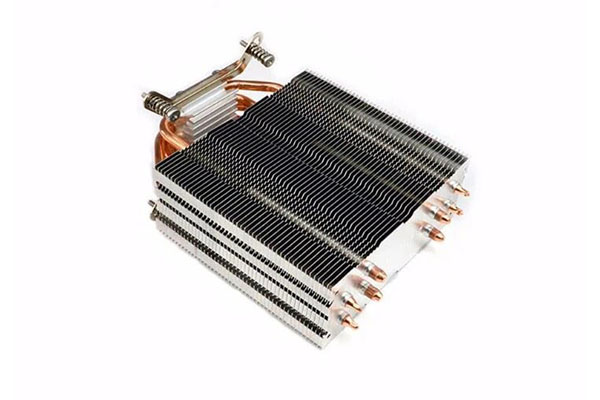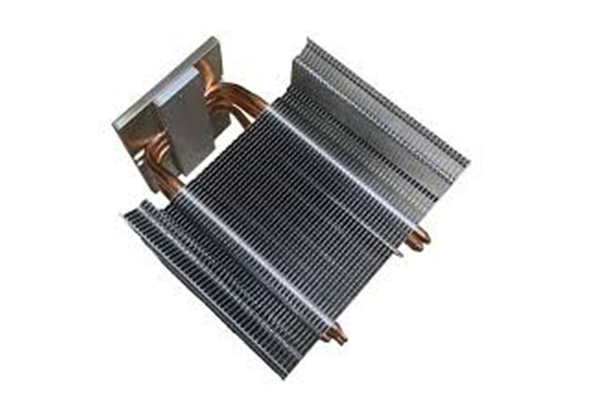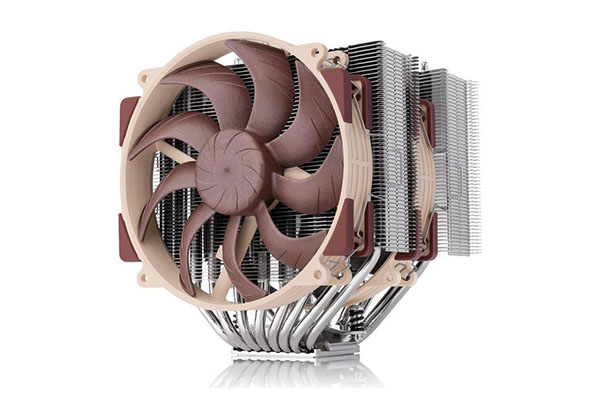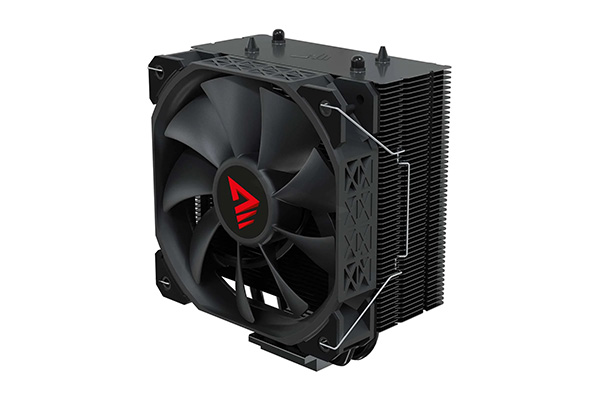Introduction
In today’s rapidly evolving world of artificial intelligence (AI) and server computing, the need for effective cooling systems has never been more critical. High-performance AI systems and servers are pushed to their limits to handle complex computations, and with this increased load, the need for proper CPU cooling is undeniable. This article will dive deep into why CPU cooling is essential for AI systems, how to choose the right CPU cooler, and the benefits of keeping your servers running at optimal temperatures. Get ready for an insightful journey into the world of CPU cooling for AI servers.

1. Why is CPU Cooling Crucial for AI Systems and Servers?
When you’re dealing with cutting-edge AI applications, such as machine learning, natural language processing, or computer vision, your servers are constantly working at full capacity. And here’s the catch: the more powerful your system, the more heat it generates. Without a proper CPU cooler, this heat can lead to thermal throttling, where your system slows down to prevent damage, or worse, overheating that could lead to hardware failure.
But here’s the kicker – cooling is not just about avoiding failures. It’s about ensuring that AI systems can perform at their peak, day in and day out, without interruptions. A high-performance CPU cooler ensures that the heat produced by your system’s processing units is effectively dissipated, maintaining optimal performance even under heavy workloads. Whether you’re running a single server or an entire farm of machines, the cooler you choose will directly affect your system’s lifespan and reliability.
AI systems are at the forefront of innovation, and their reliability is non-negotiable. If a server crashes due to heat issues, it could cost you valuable processing time, not to mention a hit to your bottom line. Therefore, understanding the significance of CPU cooling in the context of AI computing is key.
| CPU Cooler Type | Avantages | Inconvénients |
|---|---|---|
| Refroidisseurs d'air | Cost-effective, easy to install | May not be sufficient for high-power systems |
| Refroidisseurs de liquide | More efficient, handles heavy workloads | More expensive, requires maintenance |
| Hybrid Coolers | Combines best of both air and liquid | Higher cost and complexity |
2. What Are the Key Factors in Choosing a CPU Cooler for AI?
Choosing the right CPU cooler for AI systems isn’t as simple as picking the most expensive one off the shelf. It requires an understanding of several critical factors that can impact both performance and cost-effectiveness. First, consider the thermal output of your system. AI computing generates massive amounts of heat, so a CPU cooler with the capacity to handle that heat output is essential. If you’re using high-performance GPUs along with CPUs, you’ll need a cooler that can support both.
Ready for the good part? The type of cooler you select plays a crucial role. While air cooling is often sufficient for standard systems, AI servers that handle intensive tasks require more robust solutions. Liquid cooling, though more expensive, offers greater efficiency and can handle higher thermal loads. However, it’s important to weigh the benefits against the cost. Air cooling systems may be cheaper and easier to maintain but might not perform as well in the long run.
The form factor of your cooler also matters. Servers come in various configurations, and space can be a limitation. Therefore, ensuring that your cooler fits your server’s design is another crucial aspect. The last consideration is noise levels; while not a performance issue, loud fans or pumps can be disruptive in a work environment.
| Facteur | Considération | Example for AI Servers |
|---|---|---|
| Thermal Output | How much heat your system generates | High-performance GPUs require liquid cooling |
| Type de refroidisseur | Air vs. Liquid vs. Hybrid | Liquid cooling for high-power systems |
| Space Constraints | Size of your server and cooler compatibility | Slim form-factor coolers for compact servers |
3. How Do CPU Coolers Help Prevent Overheating in AI Computing?
Overheating is one of the most common and most destructive problems in AI systems. And here’s why it matters: AI systems process a massive amount of data at incredibly high speeds. This constant processing generates significant heat, and without an efficient cooling system, your AI computing systems are at risk of thermal throttling or even permanent damage.
What’s the real story? CPU coolers work by ensuring that the heat generated by the processors and other components is transferred away from the critical areas before it builds up to dangerous levels. Air coolers use fans and heat sinks to push heat away, while liquid coolers circulate fluid to absorb and transfer heat more efficiently.
In AI systems, where precision and uptime are critical, overheating isn’t just an inconvenience—it’s a risk. Effective CPU cooling ensures that your systems can handle the most demanding AI workloads without worrying about the consequences of excessive heat. It also helps improve energy efficiency, as an adequately cooled system doesn’t require as much energy to perform at peak levels.
| Méthode de refroidissement | Efficacité | Application in AI Systems |
|---|---|---|
| Air Cooling | Modéré | Suitable for lower power AI systems |
| Liquid Cooling | Haut | Ideal for high-performance AI servers |
| Hybrid Cooling | Très élevé | Best for multi-GPU setups and AI farms |
4. What Are the Benefits of Liquid Cooling Systems for AI Servers?
Liquid cooling systems are often seen as the gold standard for high-performance computing environments, including AI servers. So, why should you care? Liquid cooling is far more efficient at transferring heat away from the system than traditional air cooling methods. This is especially important when you’re running multiple processors or GPUs, as the heat generation can be overwhelming for air-based coolers.
The benefits are significant. Liquid coolers offer lower noise levels compared to air cooling systems, which can be crucial in environments where noise disruption is a concern. They also tend to have a longer lifespan and require less maintenance once installed, as opposed to air cooling systems, which may require frequent fan cleaning or replacement.
Another advantage of liquid cooling is scalability. As your AI server needs grow, you can expand or upgrade the liquid cooling system to accommodate more powerful processors. This scalability ensures that your cooling solution can keep up with advancements in AI technology without the need for a full overhaul.
| Liquid Cooling System Type | Avantages | Inconvénients |
|---|---|---|
| Custom Liquid Cooling | High performance, customizable | Expensive, complex to install |
| Pre-built Liquid Cooling | Easier installation, reliable | Still requires maintenance, higher initial cost |

5. How Does a CPU Cooler Impact the Longevity of AI Hardware?
When we think about AI systems, we often focus on their computational power and ability to perform complex tasks. However, it’s important to remember that the longevity of your hardware is just as crucial. CPU coolers help maintain the integrity of your system’s components by preventing excessive heat buildup, which can lead to premature wear and tear.
This is where it gets interesting—consistent cooling isn’t just about keeping temperatures down during heavy workloads; it’s about protecting your hardware investment. By ensuring your system operates within the recommended temperature ranges, you can avoid costly repairs and downtime caused by overheating.
By investing in high-quality CPU cooling solutions, you’re not just safeguarding your hardware; you’re also improving the reliability of your AI systems. Over time, this translates into lower maintenance costs, less frequent hardware replacements, and higher overall system efficiency.
| Cooling Benefit | Impact on AI Hardware | Result |
|---|---|---|
| Consistent Cooling | Reduces wear and tear on components | Longer lifespan, fewer breakdowns |
| Prevents Overheating | Avoids thermal stress on the CPU | Fewer hardware failures |
| Improved Efficiency | Enhances overall system performance | Increased productivity, cost savings |
6. Can a High-Performance CPU Cooler Improve AI System Performance?
Let’s talk about performance. Cooling isn’t just a necessity to keep things running—it can also make your system faster and more efficient. When your CPU cooler is working at its best, your AI system can push itself further without encountering bottlenecks caused by heat. This is where overclocking comes into play.
Here’s the catch: when a CPU is cooled effectively, it can be pushed beyond its base specifications (overclocked) to deliver even more computational power. This is particularly useful in AI applications, where every bit of extra power counts. A high-performance CPU cooler allows your system to run faster without the risk of overheating, which can lead to performance degradation.
Another aspect to consider is energy efficiency. With the right CPU cooler, your system can perform demanding tasks while consuming less energy, making it a win-win for both performance and cost-effectiveness.
| Capacité d'overclocking | Result of Effective Cooling | Example in AI Systems |
|---|---|---|
| Increased Performance | Higher processing speeds | AI model training time is reduced |
| Stable Cooling | Avoids throttling and errors | Ensures reliability in real-time AI tasks |
7. What Are the Best CPU Coolers for AI and Server Environments?
Choisir le bon CPU cooler for AI systems is not one-size-fits-all. The best solution will depend on the unique needs of your server environment, the hardware you’re using, and your specific cooling goals. So, how do you pick the right one? Let’s break it down.
The top CPU coolers for AI systems generally fall into three categories: air coolers, liquid coolers, and hybrid coolers. Refroidisseurs d'air are typically the most affordable and easiest to maintain, making them a solid choice for less demanding AI applications. However, as AI systems become more powerful, air coolers often can’t handle the high thermal output of multi-GPU setups or heavy computation workloads.
What’s the real story with liquid coolers? For high-performance systems, liquid cooling is often the go-to solution. It offers superior heat dissipation compared to air coolers and can maintain optimal temperatures even under the heaviest loads. Hybrid coolers, which combine elements of both air and liquid cooling, are becoming more popular as they offer the flexibility and performance of liquid cooling with the simplicity and cost-effectiveness of air cooling.
If you’re looking for top recommendations, consider options like the Corsair iCUE H150i Elite Capellix (liquid cooling), Noctua NH-D15 (air cooling), and NZXT Kraken Z73 (hybrid). These coolers are designed to provide consistent cooling, even for systems running at full capacity. So, when selecting the right cooler, always keep in mind the cooling capacity required for your AI workload and ensure that it is compatible with your server setup.
| Type de refroidisseur | Idéal pour | Caractéristiques principales |
|---|---|---|
| Refroidisseurs d'air | Standard AI applications | Affordable, low maintenance |
| Refroidisseurs de liquide | High-performance systems | Superior cooling, ideal for GPUs |
| Hybrid Coolers | Mixed workloads | Combines liquid and air cooling |
8. How Does Ambient Temperature Affect AI Server Cooling Needs?
It’s not just the heat inside your AI servers that matters. The ambient temperature, or the temperature of the environment surrounding your server, plays a major role in your CPU cooler’s ability to keep your system cool. Ready for the good part? A high ambient temperature means your CPU cooler has to work harder to maintain optimal internal temperatures. So, keeping your servers in a cool, controlled environment is just as important as choosing the right cooler.
AI systems often require a steady and cool temperature to function at their best. When server rooms get too hot, the efficiency of your cooling system diminishes, leading to overheating or thermal throttling. If your system can’t keep up with the heat, it can lead to a major performance drop. This is especially crucial in AI environments where uptime is essential, and every second counts.
To optimize your cooling, ensure that the room temperature stays between 18°C and 22°C. In some cases, additional air conditioning or ventilation may be necessary to maintain this temperature. You might also consider investing in cold aisle containment systems for your server racks, which can help isolate hot and cool air for more efficient cooling.
| Cooling Solution | Temperature Range | Use Case |
|---|---|---|
| Standard Air Cooling | 18°C to 22°C | Suitable for general AI workloads |
| Precision Cooling | 10°C to 18°C | Ideal for high-end AI and server farms |
| Liquid Cooling | 15°C to 25°C | Best for powerful multi-GPU setups |
9. What Are the Common Challenges in Cooling AI Computing Systems?
AI computing systems present unique challenges when it comes to cooling. As processing power increases, so does the amount of heat generated. And here’s the kicker – cooling solutions that work for standard computing may not be enough for AI workloads. The heavy demands of AI processes, especially those that involve deep learning, large-scale data analysis, ou high-performance GPUs, make traditional cooling methods inefficient.
But wait, there’s more to it. AI servers often operate in dense server farms, where space is limited and cooling efficiency is paramount. Limited airflow, combined with the massive heat load, can lead to inconsistent cooling and poor system performance. To make things worse, cooling solutions must be both effective and energy-efficient, balancing power consumption with cooling efficiency.
Another significant challenge is noise control. High-performance cooling systems, especially liquid coolers, can generate significant noise levels. In a server farm where hundreds of machines may be running at once, this noise can become overwhelming, affecting both worker productivity and the functioning of the data center.
| Cooling Challenge | Impact | Solution |
|---|---|---|
| Limited Space | Restricted airflow and cooling capacity | Optimized cooling design, compact coolers |
| High Power Demand | Increased energy consumption | Hybrid cooling systems, energy-efficient coolers |
| Niveaux de bruit | Disrupts working environment | Choose quieter cooling systems or soundproofing |

10. How Do You Install a CPU Cooler in an AI Server?
Installing a CPU cooler in an AI server might sound like a daunting task, but with the right steps and preparation, it’s quite straightforward. Here’s the deal – the installation process can vary depending on whether you’re using an air or liquid cooler, but the general steps remain consistent.
Start by ensuring your system is powered off and unplugged. Once you’ve removed the case cover and identified the CPU socket, you’ll want to clean off any old thermal paste from the CPU and cooler. Next, carefully install the mounting bracket for your cooler, ensuring that it’s securely fastened to the motherboard. After this, apply a small amount of fresh thermal paste to the CPU, which helps improve heat transfer between the cooler and processor.
For air coolers, attach the cooler to the bracket using the provided screws, making sure it’s aligned correctly. With liquid coolers, you’ll need to install the radiator and connect the pump to the CPU. Always ensure that the radiator is properly secured and that there’s no obstruction to airflow. Once installed, reconnect the system, power it up, and check temperatures using monitoring software to ensure everything is running smoothly.
| Type de refroidisseur | Installation Complexity | Time Required |
|---|---|---|
| Refroidisseurs d'air | Faible | 30–60 minutes |
| Refroidisseurs de liquide | Medium | 60–90 minutes |
| Hybrid Coolers | Haut | 90+ minutes |
11. What Are the Costs Associated with High-Performance CPU Coolers?
When selecting a CPU cooler for your AI system, cost is a major factor. Ready for the kicker? The best-performing coolers often come with a hefty price tag, but they are worth the investment in the long run, especially for high-end AI systems where reliability and performance are key.
Air coolers are typically the most affordable option, with prices ranging from $50 to $150. These coolers are suitable for moderate workloads, but they may struggle to maintain optimal temperatures under heavy AI computations. Liquid coolers are more expensive, typically ranging from $100 to $300, but they offer superior cooling performance, especially for multi-GPU systems. For the most demanding AI systems, hybrid coolers, which combine the benefits of both air and liquid cooling, can cost upwards of $300.
Beyond the initial investment, it’s important to factor in the ongoing maintenance costs of the cooling system. Air coolers require periodic fan cleaning or replacement, while liquid coolers may need occasional coolant refills or maintenance. These costs should be factored into the total cost of ownership when choosing your cooling solution.
| Type de refroidisseur | Gamme de prix | Maintenance Cost |
|---|---|---|
| Refroidisseurs d'air | $50–$150 | Faible |
| Refroidisseurs de liquide | $100–$300 | Modéré |
| Hybrid Coolers | $150–$300+ | Haut |
12. What Are the Signs That Your AI System Needs Better Cooling?
If you’ve noticed your AI system slowing down or behaving erratically, it may be time to upgrade your cooling solution. Overheating doesn’t always result in immediate failure; in fact, it can cause a gradual decline in performance that you may not immediately notice. So, what’s the first sign? Watch out for sudden slowdowns during heavy AI computations or after prolonged usage.
If your CPU temperatures consistently exceed safe operating levels, it’s time to take action. Systems that are not effectively cooled often experience crashes or sudden shutdowns to prevent damage. Another indicator is the loud noise coming from fans. If the fans are running at full speed more than usual, it could indicate that the system is working harder to cool itself down.
Monitoring software can help track your system’s temperature and pinpoint cooling issues early. If temperatures are consistently high, or your system is throttling performance to deal with excess heat, upgrading your cooler is the next logical step.
| Indicator | Action Needed | Potential Issue |
|---|---|---|
| High CPU Temperature | Upgrade to more efficient cooling | Overheating, thermal throttling |
| Frequent Shutdowns | Check cooling system | Potential hardware damage |
| Excessive Fan Noise | Replace or upgrade cooler | Insufficient cooling, worn-out components |
13. How Do Overclocking and CPU Cooling Work Together in AI Systems?
Overclocking is a common practice in AI systems where performance is paramount. But here’s the kicker – while overclocking boosts your system’s processing power, it also generates significantly more heat. This is where cooling plays a major role. Effective cooling is necessary to ensure that overclocked components remain stable during AI computations.
What’s the real story? Without sufficient cooling, overclocked CPUs can overheat, causing system crashes or even permanent damage. Liquid cooling systems are typically preferred for overclocked AI systems because they can handle the higher thermal loads more efficiently. However, if you’re using air cooling, it’s crucial to ensure that the cooler is capable of handling the additional heat generated by overclocking.
In AI systems, the benefits of overclocking include faster data processing and reduced training times. But remember, stable performance requires stable temperatures, which is why overclocking and CPU cooling go hand in hand.
| Overclocking Benefit | Cooling Requirement | Recommended Solution |
|---|---|---|
| Increased Performance | Higher cooling capacity | Liquid cooling systems |
| Reduced Processing Time | Stable temperature | High-end air or liquid cooling |
| Enhanced GPU/CPU Power | Consistent cooling | Custom cooling solutions |
14. Can You Use Off-the-Shelf CPU Coolers in AI Server Farms?
AI server farms are designed to handle large-scale, high-performance computing tasks, which means they generate an enormous amount of heat. So, can off-the-shelf CPU coolers cut it in these environments? The simple answer is no. While consumer-grade coolers are fine for home systems or low-power servers, they’re not designed for the heavy workloads and dense configurations found in AI server farms.
What’s the catch? Off-the-shelf coolers lack the cooling capacity needed for multi-GPU systems or high-density server racks. For AI server farms, you’ll need specialized industrial coolers designed to handle the specific thermal demands of these setups. Liquid and hybrid cooling systems are often the go-to choice for large-scale AI server farms due to their superior cooling efficiency.
| Cooling Solution | Suitability | Use Case |
|---|---|---|
| Off-the-Shelf Coolers | Low-performance systems | Small-scale AI or non-intensive tasks |
| Industrial Coolers | High-performance farms | Large-scale AI systems, multi-GPU setups |
| Hybrid Systems | Mixed workloads | Best for diverse server environments |
15. What Are the Future Trends in CPU Cooling for AI and Servers?
The world of AI computing is evolving at a rapid pace, and so are the cooling solutions designed to support it. Ready for the good part? In the coming years, we’re likely to see even more innovative and efficient cooling solutions tailored specifically for AI systems.
Trends include the rise of direct-to-chip cooling, where coolants are delivered directly to processors, bypassing traditional air or liquid cooling systems. Another trend is the development of smart cooling technologies, which use sensors and AI to adjust the cooling capacity based on real-time needs. This will improve energy efficiency while keeping temperatures in check.
As AI systems become even more powerful, cooling solutions will need to scale up to keep pace. The future of AI computing will likely see an increase in hybrid cooling systems, which combine air, liquid, and possibly new technologies to ensure optimal performance across diverse workloads.
| Trend | Impact on AI Systems | Key Benefit |
|---|---|---|
| Direct-to-Chip Cooling | More efficient cooling | Reduces energy consumption |
| Smart Cooling Solutions | Adjusts based on real-time data | Improves energy efficiency |
| Hybrid Cooling Systems | Handles diverse workloads | Scalable, flexible cooling solution |

Section FAQ
Q1: Qu'est-ce qu'un refroidisseur de processeur ?
A CPU cooler is a device designed to dissipate the heat generated by a computer’s processor to prevent overheating, ensuring optimal performance.
T2 : How does liquid cooling work for servers?
Liquid cooling systems circulate coolant to absorb heat from the processor, offering more efficient heat dissipation than air coolers, which is crucial for AI servers.
T3 : How can I tell if my AI system is overheating?
You can monitor temperature using software tools that alert you when your system reaches unsafe levels, or watch for signs like sudden system slowdowns or shutdowns.
T4 : What is the difference between air and liquid cooling for AI systems?
Air cooling uses fans to move heat away, while liquid cooling uses coolant to transfer heat more efficiently, making liquid cooling more suitable for high-performance AI systems.
Q5 : Can upgrading my CPU cooler improve AI system performance?
Yes, upgrading to a high-performance CPU cooler can prevent overheating, allow for overclocking, and improve the overall efficiency and speed of AI tasks.

